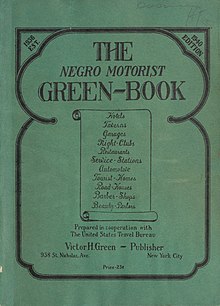
Back الكتاب الأخضر لسائق السيارات الزنجي Arabic The Negro Motorist Green Book AST کتێبی سەوز CKB The Negro Motorist Green Book German کتاب سبز Persian The Negro Motorist Green Book French מדריך גרין לנהג השחור HE The Negro Motorist Green Book Italian 黒人ドライバーのためのグリーン・ブック Japanese The Negro Motorist Green Book Malay
 Cover of the 1940 edition | |
| Author | Victor Hugo Green |
|---|---|
| Country | United States |
| Language | English |
| Genre | Guide book |
| Publisher | Victor Hugo Green |
| Published | 1936–1966 |
The Negro Motorist Green Book (also, The Negro Travelers' Green Book, or Green-Book) was a guidebook for African American roadtrippers. It was founded by Victor Hugo Green, an African American postal worker from New York City, and was published annually from 1936 to 1966. This was during the era of Jim Crow laws, when open and often legally prescribed discrimination against African Americans especially and other non-whites was widespread. While pervasive racial discrimination and poverty limited black car ownership, the emerging African American middle class bought automobiles as soon as they could but faced a variety of dangers and inconveniences along the road, from refusal of food and lodging to arbitrary arrest. In the South, where Black motorists risked harassment or physical violence, these dangers were particularly severe. In some cases, African American travelers who got lost or sought lodging off the beaten path were killed, with little to no investigation by local authorities. In response, Green wrote his guide to services and places relatively friendly to African Americans. Eventually, he also founded a travel agency.
Many black Americans took to driving, in part to avoid segregation on public transportation. As the writer George Schuyler put it in 1930, "all Negroes who can do so purchase an automobile as soon as possible in order to be free of discomfort, discrimination, segregation and insult".[1] Black Americans employed as athletes, entertainers, and salesmen also traveled frequently for work purposes using automobiles that they owned personally.
African American travelers faced discrimination, such as white-owned businesses refusing to serve them or repair their vehicles, being refused accommodation or food by white-owned hotels, and threats of physical violence and forcible expulsion from whites-only "sundown towns". Green founded and published the Green Book to avoid such problems, compiling resources "to give the Negro traveler information that will keep him from running into difficulties, embarrassments and to make his trip more enjoyable".[2] The maker of a 2019 documentary film about the book offered this summary: "Everyone I was interviewing talked about the community that the Green Book created: a kind of parallel universe that was created by the book and this kind of secret road map that the Green Book outlined".[3]
From a New York-focused first edition published in 1936, Green expanded the work to cover much of North America, including most of the United States and parts of Canada, Mexico, the Caribbean, and Bermuda. The Green Book became "the bible of black travel during Jim Crow",[4] enabling black travelers to find lodgings, businesses, and gas stations that would serve them along the road. It was little known outside the African American community. Shortly after the passage of the Civil Rights Act of 1964, which outlawed the types of racial discrimination that had made the Green Book necessary, publication ceased and it fell into obscurity. There has been a revived interest in it in the early 21st century in connection with studies of black travel during the Jim Crow era.
Four issues (1940, 1947, 1954, and 1963) have been republished in facsimile (as of December 2017[update]) and have sold well.[5] Twenty-three additional issues have now been digitized by the New York Public Library Digital Collections.[6]
- ^ Franz, p. 242.
- ^ Cite error: The named reference
Franz246was invoked but never defined (see the help page). - ^ Yeo, Debra (19 February 2019). "The real book behind Green Book: a means to keep black Americans safe but also a guide to having fun". The Toronto Star. Archived from the original on 14 January 2020. Retrieved 17 April 2019.
- ^ Cite error: The named reference
WaPowas invoked but never defined (see the help page). - ^ Flood, Alison (December 17, 2017). "Travel guides to segregated US for black Americans reissued". The Guardian. Archived from the original on December 31, 2019. Retrieved February 10, 2018.
- ^ "The Green Book - NYPL Digital Collections". digitalcollections.nypl.org. Archived from the original on 2020-01-09. Retrieved 2017-12-29.